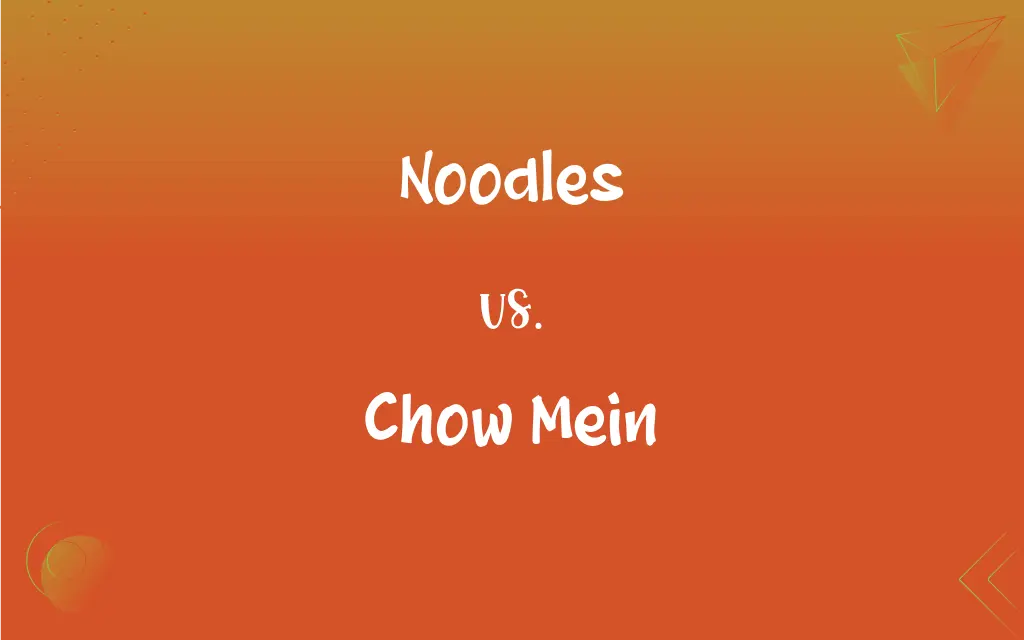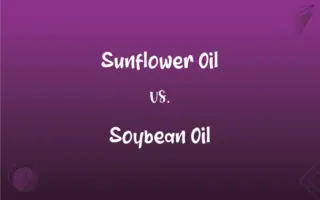Noodles vs. Chow Mein: What's the Difference?
Edited by Aimie Carlson || By Janet White || Published on December 17, 2023
Noodles are thin, elongated dough strips, versatile in many cuisines; Chow Mein is a Chinese dish featuring stir-fried noodles with vegetables and meat.

Key Differences
Noodles, a staple in various cuisines, are made from unleavened dough, rolled flat and cut into long strips or strings. They can be prepared in boiling water, with cooking styles varying widely across cultures. Chow Mein, on the other hand, is a specific Chinese dish that utilizes noodles as its main ingredient. It's typically made by stir-frying noodles with a choice of vegetables, meat, or seafood, often flavored with soy sauce, garlic, and other seasonings.
While noodles serve as a base for countless recipes worldwide, varying in shape, size, and ingredients based on region, Chow Mein is specifically a Chinese-origin dish with a distinct cooking method and set of ingredients. Noodles in Chow Mein are often cooked to a crispier texture compared to other noodle dishes, providing a unique mouthfeel.
The versatility of noodles is evident in their use across many different dishes; from Italian pasta to Japanese ramen, they adapt to the flavors and techniques of diverse culinary traditions. Chow Mein, in contrast, is recognized for its specific taste and style, reflecting traditional Chinese cooking practices and flavors.
The preparation of noodles varies widely - they can be stir-fried, boiled, or baked, and served in soups, salads, or as main courses. Chow Mein, specifically, involves a particular technique of stir-frying the noodles with a high heat that imparts a distinct "wok hei" or wok flavor, a characteristic not commonly found in other noodle dishes.
In summary, while noodles are a fundamental component in various dishes across different cuisines, Chow Mein is a particular dish from Chinese cuisine that features stir-fried noodles with a unique set of ingredients and cooking techniques.
ADVERTISEMENT
Comparison Chart
Origin
Global, found in various cuisines.
Specifically Chinese.
Preparation
Boiled, baked, or stir-fried.
Primarily stir-fried.
Texture
Can vary - soft, chewy, or crispy.
Often crispy from stir-frying.
Serving Style
In soups, salads, or as a main dish.
As a main dish, rarely in soups.
Cultural Significance
Universal, adaptable to many cultures.
Strongly tied to Chinese cuisine.
ADVERTISEMENT
Noodles and Chow Mein Definitions
Noodles
A basic food ingredient, common in Asian cuisine.
We ordered spicy noodles at the Thai restaurant.
Chow Mein
Noodles fried to a crispy texture, mixed with savory sauces.
She loved the crunch of the chow mein noodles.
Noodles
Flexible dough strips, often made from wheat or rice.
He added rice noodles to the stir-fry for a gluten-free meal.
Chow Mein
Includes a variety of toppings like shrimp, pork, or tofu.
He made vegetarian chow mein with tofu and vegetables.
Noodles
Eaten boiled, fried, or in soups, a staple in many diets.
For dinner, they had noodles tossed in a rich tomato sauce.
Chow Mein
A Chinese dish of stir-fried noodles with vegetables and meat.
He ordered chicken chow mein for takeout.
Noodles
Thin, elongated strips of dough, cooked in boiling water.
She savored the homemade noodles in her chicken soup.
Chow Mein
A popular Asian cuisine dish, known for its unique flavor.
Their favorite dish at the Chinese restaurant was beef chow mein.
Noodles
A versatile food item, used in various dishes worldwide.
She learned to make Italian noodles from scratch.
Chow Mein
Often seasoned with soy sauce and spices, a hearty meal.
They cooked a large wok of chow mein for the family gathering.
Noodles
A narrow, ribbonlike strip of dough, usually made of flour, eggs, and water.
Noodles
The human head.
Noodles
A weak, foolish, or stupid person.
Noodles
To improvise music on an instrument in an idle, haphazard fashion.
Noodles
To catch or try to catch a fish, usually a catfish, by hand, characteristically by allowing the fish to bite one's hand or placing one's hand in the fish's mouth, and then grabbing the fish by the mouth or through the gills.
Noodles
Plural of noodle
FAQs
Can noodles be gluten-free?
Yes, when made from rice or other gluten-free grains.
What distinguishes chow mein from other noodle dishes?
Its specific stir-fry technique and Chinese flavor profile.
Can noodles be eaten cold?
Yes, in dishes like cold noodle salads.
What are noodles made from?
Typically wheat or rice flour and water.
What's the typical protein in chow mein?
Chicken, beef, shrimp, or tofu.
Are all noodles long and thin?
No, they come in various shapes and sizes.
Are noodles used in both Asian and Western cuisines?
Yes, they're a staple in many global cuisines.
Is chow mein always made with noodles?
Yes, noodles are a key ingredient in chow mein.
Is chow mein typically a spicy dish?
It can be, but it's not inherently spicy.
Can chow mein be made vegetarian?
Yes, by using tofu or only vegetables.
Is pasta a type of noodle?
Yes, it's an Italian variety of noodles.
What makes chow mein crispy?
The high heat stir-frying process.
Can noodles be used in desserts?
Yes, in some cultures, like sweet noodle kugel.
How is chow mein sauce made?
Usually with soy sauce, garlic, and oyster sauce.
What's the difference between noodles and spaghetti?
Spaghetti is a type of Italian noodle with a specific shape.
Do noodles have a long shelf life?
Yes, especially when dried.
Do all chow mein dishes have vegetables?
Typically, but variations exist.
Are noodles a healthy food choice?
It depends on the ingredients and preparation.
Is chow mein eaten as a main dish or side?
It's commonly served as a main dish.
Is chow mein different from lo mein?
Yes, lo mein is less crispy with a different cooking method.
About Author
Written by
Janet WhiteJanet White has been an esteemed writer and blogger for Difference Wiki. Holding a Master's degree in Science and Medical Journalism from the prestigious Boston University, she has consistently demonstrated her expertise and passion for her field. When she's not immersed in her work, Janet relishes her time exercising, delving into a good book, and cherishing moments with friends and family.
Edited by
Aimie CarlsonAimie Carlson, holding a master's degree in English literature, is a fervent English language enthusiast. She lends her writing talents to Difference Wiki, a prominent website that specializes in comparisons, offering readers insightful analyses that both captivate and inform.






































































